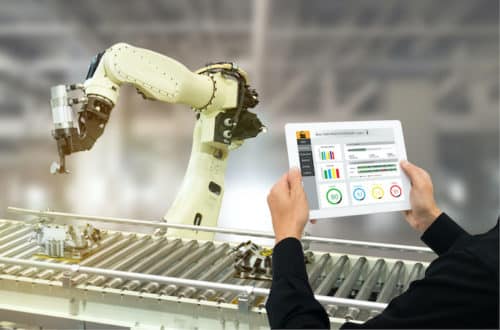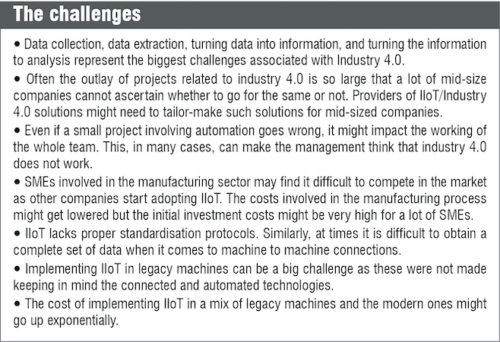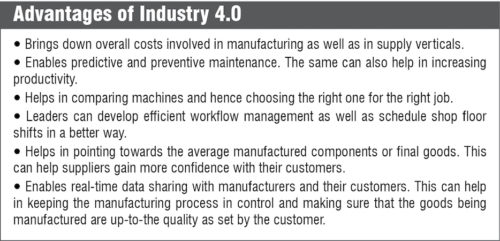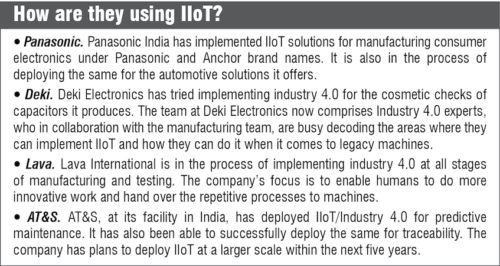Several reasons, including coronavirus, geopolitical conditions, and looking beyond one country for manufacturing needs, have once again sparked the need for implementing IIoT on a bigger scale. But, is anyone in electronics manufacturing investing in it?
The outbreak of Covid-19 has increased the need for adoption of IIoT/Industry 4.0 solutions. A lot of companies have started looking at automating manufacturing processes to reduce difficulties arising due to human errors.
In numbers, the Industrial Internet of Things (IIoT) market in India was valued at 7.43 million dollars in 2018, as per a report by Maximize Market Research. The report further states that the global IIoT market is expected to grow from 77.3 billion dollars in 2020 to 110.6 billion dollars by 2025, at a CAGR of 7.4 per cent.
According to Markets and Markets, the APAC region, which includes India, is forecast to hold the largest share of IIoT. But on the ground, the challenges are far greater than what these reports mention.
“Industry 4.0 sounds to me like teenage **x. Everyone thinks everyone else is doing it, but in reality, no one is doing it. There are a lot of things bundled under Industry 4.0. I don’t think any of us can claim that we have achieved 100 per cent Industry 4.0. There is a long way to go for every one of us, and the road to Industry 4.0 is long,” points out Sunil Banwari, COO, AT&S.

The Coronavirus Connection
A report published in McKinsey states that IIoT can help companies maintain a smooth flow of operation during the pandemic times. It is not a hidden fact that almost all the manufacturers, irrespective of the vertical they were in, were forced to shut down operations to make sure that humans working on shop floors do not become carriers of the virus.
In fact, as per the estimations made by the United Nations Conference on Trade and Development (UNCTAD), the Covid-19 outbreak could cause global FDI to shrink by five to fifteen per cent due to the downfall in the manufacturing sector coupled with factory shutdowns. These estimations, coupled with the decreasing demand for goods, sound like a perfect recipe for disaster in the manufacturing sector, which in turn will affect global GDPs and economies.
Several reports that mentioned the workforce is migrating back to their native villages added more fuel to the fire. It simply represents the fact that even if demand starts to rise again, manufacturers might not find workforce to compliment the same. Also, the cost of making arrangements for people to return from their native places to workplaces would be an added burden on manufacturers in the already tumbling economic reality.
India’s GDP contracting by about 24 per cent in the June quarter is a sign that one shouldn’t miss. All emerging countries, except China, witnessed GDP contractions in the range of five to nineteen per cent (Mint report). China’s GDP, on the other hand, grew by almost three per cent even though coronavirus originated from this country.
The Big Picture
China’s spending on smart manufacturing has surged year-on-year. In 2018, this investment shot up by 46 per cent and amounted to RMB 69.9 billion. Xi Jinping, president of China, had called for a robot revolution during a 2014 speech. The country since then has been aggressively investing in automating manufacturing processes. According to the International Federation of Robotics, Chinese companies installed 154,000 industrial robots in 2018, beating Japan at 55,200 and the US at 40,400.
“The topic of IIoT could not have been discussed at a better time than the time we are going through. Digital as an option has been picking pace in the last five to six months. Industry 4.0 is a very interesting area. Different manufacturing facilities and technologies are at different levels of maturity. We at Panasonic India are not only rolling out automation solutions for the manufacturing industry, but we are also deploying these at a lot of Panasonic facilities in India,” shares Manish Misra, CIO, Panasonic India.
Vinod Sharma, MD, Deki Electronics, mentions that his company (an SME) has been looking at Industry 4.0 as a blind man looks at an elephant. He says, “IIoT technologies can help in bringing down costs to some extent. These could be via preventive maintenance, predictive maintenance, and by increasing productivity.’’
“IIoT gives us an analytical framework to dwell at a place. Our finding out of IIoT is that when big companies offer outlays on how to implement IIoT for small companies like us, the cost factor often scares us. Till now, we have had limited access to IIoT. We have also learned to stay away from implementing IIoT in some areas. We tried to do visual inspections of millions of capacitors we manufacture every day, and we learned that the technology has not matured enough to be implemented there,” he adds.
Sharma also notes that the current pandemic is accelerating the adoption of IIoT as the economies have started looking beyond just one source for their manufacturing needs. In his regard, the IIoT can further accelerate the process of making more manufacturing hubs in the world, as it can bring manufacturing near places where the demand is on the higher side.
“It might not mean that things will remain positive for SMEs. But we need to carefully place our bets on the right parts of IIoT. We need to embrace the change for good,” he says.
Let’s Get Started
To start with, there exist machines that are capable of working 24 hours a day and seven days a week, without taking any breaks. Next is the reduced error in manufacturing owing to the data collected and fed in such machines. Then comes long-term data and its analysis. The same can help in managing better productivity shifts and better quality products.
A report by IDC had highlighted that an increase in the quality of products manufactured helps in lowering down the amount of waste generated. It is a simple fact that lower waste generated is directly proportional to lower costs for manufacturing.
“Whether you implement IIoT fully or at some stages, the same promises efficiency, accuracy, and capability. Now some people can claim that they have implemented IIoT fully, but there is still a long way to go. I see these three things as the biggest advantages of implementing IIoT,” notes Sanjeev Agarwal, chief manufacturing officer, Lava International.
He adds, “The three factors have been important for every manufacturer since the inception of manufacturing. However, with increased competition and increased demand from customers, these have become critical now. IIoT can help in reducing costs, making products better, and increasing profits.”
An MPI (composed of the Management Performance Institute, the Marketing Performance Institute, and the Manufacturing Performance Institute) Internet of Things Study (2017), sponsored by Binder Dijker Otte (BDO), found that manufacturers in the United States are making headway toward embracing IoT and improving their readiness—more than half (51 per cent) characterise themselves as IoT-competitive companies, and another fourteen per cent say that they’re IoT leaders. Seventy two per cent of manufacturers (who contributed to the study) reported that the application of IoT in their plants and processes resulted in increased productivity last year, while sixty nine per cent reported an increase in profitability, with twelve per cent reporting an increase of more than ten per cent.
On where to start with implementing IIoT, Sanjeev Agarwal says, “Processes of manufacturing requiring repetitive tasks should be handed over to machines. Humans involved in manufacturing processes should be more involved in creating value. They should be working on innovating new processes or making the existing processes better.”
Challenges in adopting Industry 4.0
Despite the proven advantages, the adoption of IIoT has not been that promising, especially in India. Not just India, a recent report by IDC noted that the worldwide spending on the Internet of Things (IoT) has been significantly impacted by the economic effects of the Covid-19 pandemic in 2020, although a back to double-digit growth rebound is expected both in the mid and long-term.
A new update to the International Data Corporation (IDC) Worldwide Internet of Things Spending Guide shows IoT spending growing 8.2 per cent year over year to 742 billion dollars in 2020, down from 14.9 per cent growth forecast in November 2019 release.
Nevertheless, IDC expects that global IoT spending will return to double-digit growth rates in 2021 and achieve a CAGR of 11.3 per cent over the 2020-2024 forecast period.
“The very first challenge in adopting IIoT is the lack of proper standardisation. The same requires a lot of work and heavy lifting. Secondly, if you look at it from a machine-to-machine point of view, it becomes difficult to get a complete set of data from the two. The challenge amplifies when you look at the legacy machines’ point of view,” notes Manish Misra.
The number of SMEs and big companies using legacy machines for manufacturing is huge. Embedding such machines with sensors or data loggers is as big a challenge as it is an opportunity. One of the main reasons that manufacturers do not switch to new machines is the feeling that legacy machines are easy to repair. Additionally, the cost of replacing a whole system of a legacy machine with new ones sounds a little on the expensive side to many.
“I am not sure whether the next one is a challenge or just a misconception, but many organisations feel that implementing IIoT can be a costly affair. We need to understand that not all stages require implementing IIoT at one go. The companies can do so in a stage-by-stage manner. The focus should be on the convergence of IT and OT. Aligning smart manufacturing is a work in process and rethinking flow of operations is management’s task to assess,” adds Manish Misra.

“The cost of implementing IIoT for an SME like us goes up exponentially when legacy and modern machines are considered collaboratively. Another challenge is the set of people who believe that they manufacture efficiently without having these fancy processes in place,” notes Vinod Sharma.
Traceability: The Big Advantage
“IIoT is all about scale and pricing. As someone who supplies PCB as a component, AT&S needs to make sure that these have the reliability at competitive pricing. The most important thing is quality. We ensure quality from a customer’s point of view using the traceability and data systems verticals of IIoT. We have seen tremendous results in the past,” says Sunil Banwari.
“From a customer’s point of view, they want a peace of mind with every single unit of PCB we deliver to them. Having the information systems in place ensure that the traceability does not get missed. If there are errors in a PCB, we can trace down the entire lot for the customer so that the customer does not need to shut its entire operations,” adds Sunil Banwari.
A detailed report by Deloitte mentioned that distributed ledger technologies (blockchain technology) and IoT have the potential to solve important glitches in traceability and provenance challenges. In fact, in Deloitte’s 2013 global supply chain risk survey, almost two thirds (63 per cent) of respondents identified risk in the extended value chain—comprising vendors and customers—as their greatest concern with regards to supply chain risk.

“In many cases, we have been able to have professionals from our sites outside India log in and troubleshoot problems for us and our customers. IIoT, undoubtedly, creates a field where internal communication as well as external communication is in real time. The problems get solved on a real-time basis. Additionally, it helps all our facilities and, in some cases, our customers as well, to address problems collaboratively,” points out Sunil Banwari.
Creating jobs or killing them?
Automation means the removal of humans and their intervention. So, is it correct to assume that IIoT will spell a lot of job losses? Interestingly, all spokespersons believed that IIoT would actually create new jobs. The requirement for professionals is to reskill and upskill themselves and embrace the revolution that is taking place in the IIoT industry.
Arpit Chhabra, CEO, IoTfy, notes that individuals will have to play active roles in innovating new manufacturing processes.
“When computers were introduced into the banking system, a lot of people started fearing job losses. However, more high-paying jobs got introduced. The same will happen with IIoT. The value-addition that a human can do is going to add new avenues for people who are otherwise doing repetitive work. IIoT is not going to have any impact on the job scenario. As a matter of fact, a company that is introducing IIoT to its manufacturing process is going to witness a positive impact on the quality produced,” concludes Arpit Chhabra.

China, the United States, and Western Europe, as per the latest IDC report, will account for roughly three-quarters of all IoT spending throughout the forecast. Although the three regions will have similar spending totals initially, China’s spending will grow at a faster rate than the other two regions—13.4 per cent CAGR compared to nine per cent and 11.4 per cent—enabling it to become the dominant region for IoT spending. The fastest IoT spending growth will be in the Middle East and Africa, Central and Eastern Europe, and Latin America regions. The report does not mention India anywhere.






